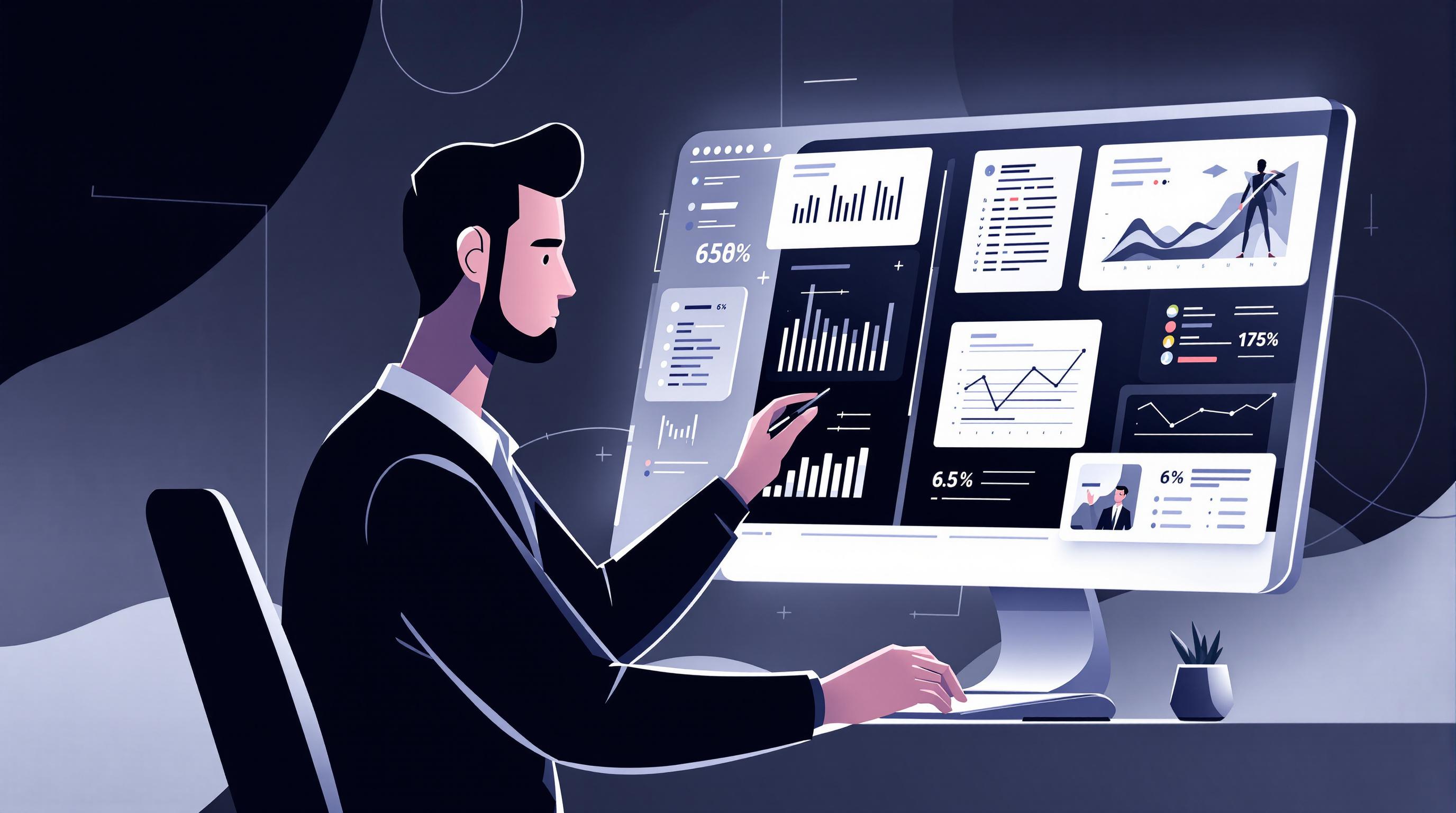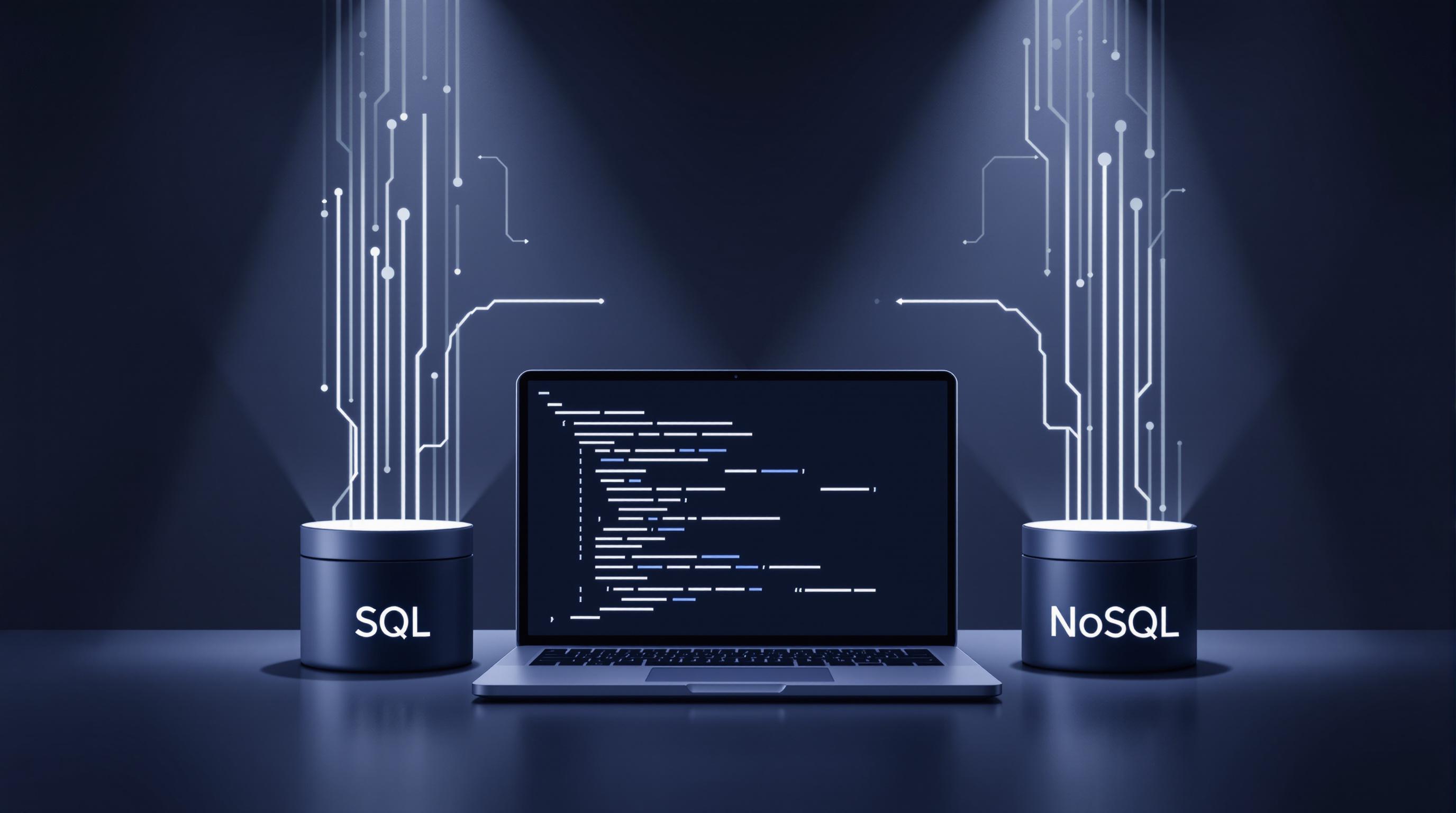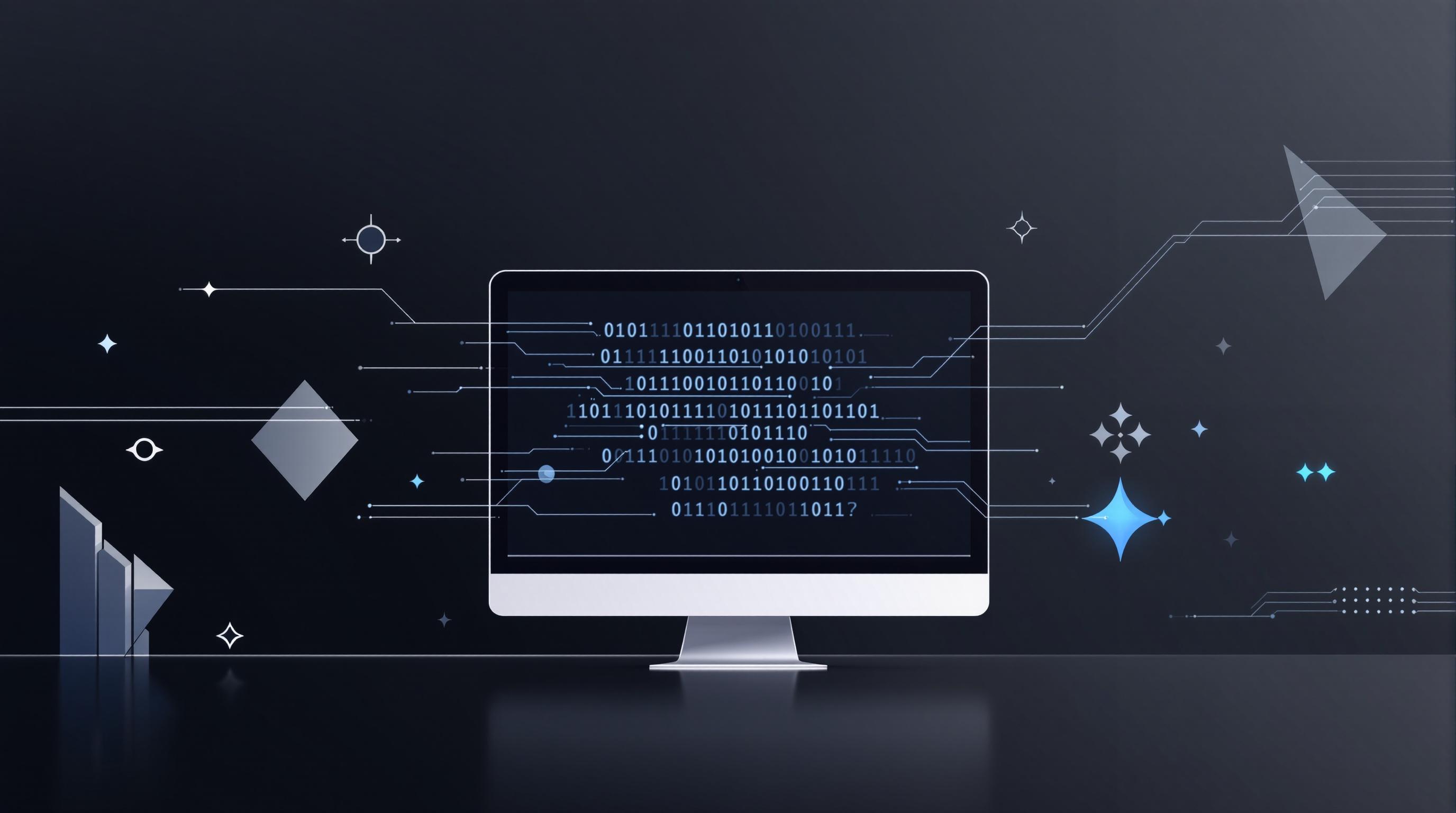Web scraping is a method businesses use to collect and analyze online data to understand consumer behavior. With 62.3% of the global population using social media and 76% of consumers expecting companies to meet their needs, web scraping helps businesses stay competitive by uncovering trends, preferences, and market dynamics. Here’s how it works and why it matters:
- What It Does: Automates data collection from websites like e-commerce platforms, social media, and review sites.
- Why It’s Useful: Helps businesses track prices, analyze customer reviews, monitor social media sentiment, and predict trends.
- Tools: Popular options include BeautifulSoup (simple tasks), Scrapy (large-scale projects), and Selenium (dynamic content).
- Legal & Ethical Compliance: Follow website rules, respect privacy laws like GDPR and CCPA, and use APIs when possible.
- Real-World Impact: Examples include improving product features based on reviews, adjusting pricing strategies, and responding to social media feedback.
Quick Comparison of Web Scraping Tools
| Feature | BeautifulSoup | Scrapy | Selenium |
|---|---|---|---|
| Language | Python | Python | Python |
| Use Case | Small tasks | Large-scale tasks | Dynamic content |
| Ease of Use | Easy | Requires setup | Complex setup |
| Speed | Fast | Moderate | Slower |
Web Scraping | Consumer Review Analysis Using NLP and Machine Learning | Data Science Project
Web Scraping Tools and Methods
Selecting the right web scraping tools can mean the difference between a smooth data collection process and hours of unnecessary frustration. The world of web scraping offers a variety of tools designed to meet different data extraction needs. By understanding these tools and their methods, you can gather consumer behavior data more efficiently.
Popular Tools: BeautifulSoup, Scrapy, and Selenium
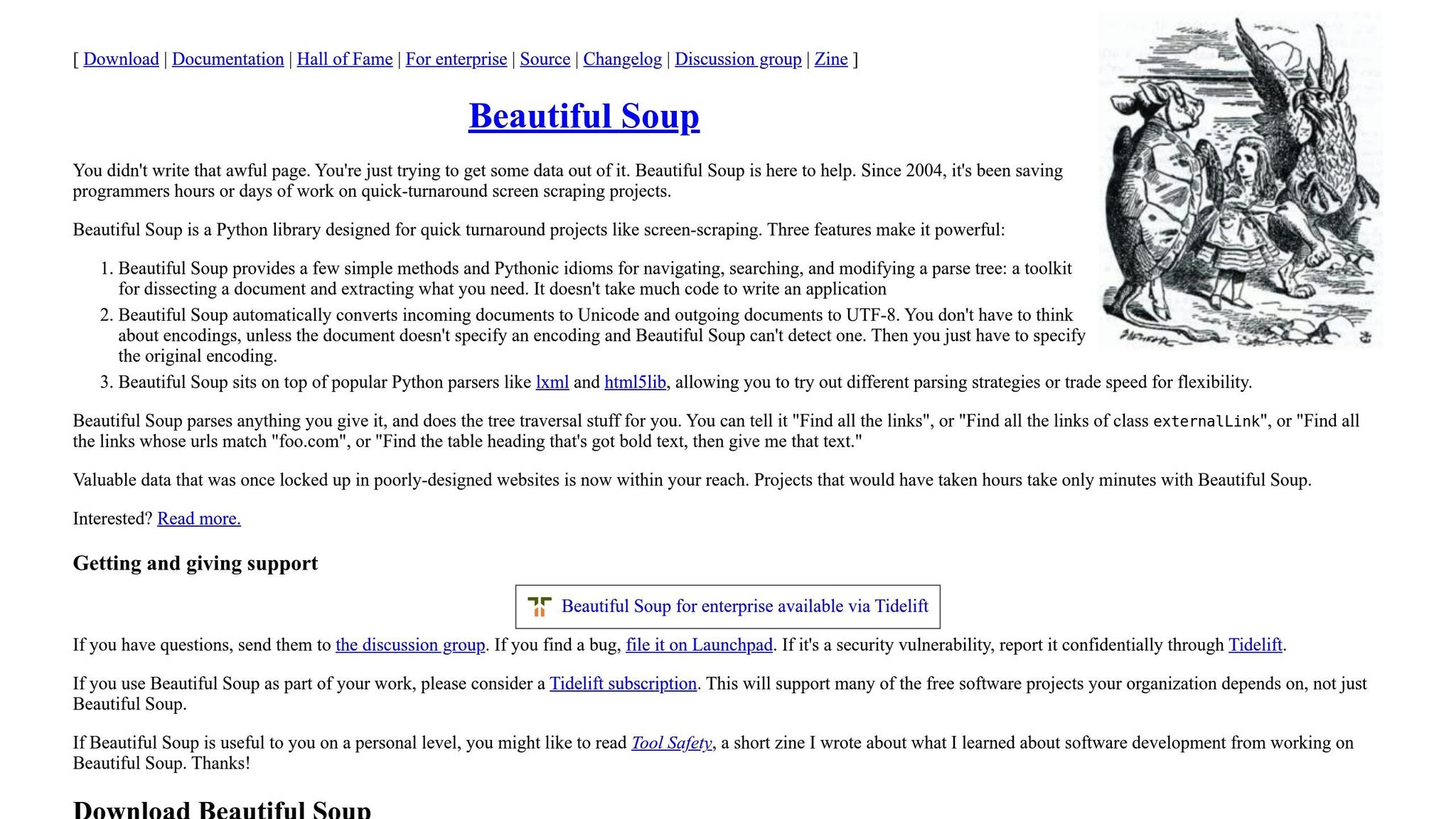
When it comes to web scraping, three tools dominate the space: BeautifulSoup, Scrapy, and Selenium. Each has its own strengths, making them suitable for different types of consumer behavior analysis.
BeautifulSoup is a favorite among developers, with approximately 710,000 users. It’s a Python library that excels at parsing HTML and XML, making it perfect for extracting specific data like customer reviews, product details, and pricing from static web pages. If you're working on focused tasks - say, gathering data from an e-commerce site’s product pages - BeautifulSoup is a quick and reliable choice.
Scrapy, on the other hand, is a full-blown web scraping framework tailored for large-scale projects. With around 40,400 users, it’s built for businesses that need to manage and analyze massive datasets. Scrapy combines HTTP client capabilities with powerful parsing tools, making it ideal for monitoring broad consumer behavior trends.
Selenium is a different beast altogether. It automates web browsers, allowing you to scrape JavaScript-heavy websites that dynamically load content. This makes it invaluable for modern platforms like social media and e-commerce sites. When paired with BeautifulSoup, Selenium can scrape data across multiple pages and handle complex scenarios, such as asynchronous content loading.
| Feature | Scrapy | BeautifulSoup |
|---|---|---|
| Language | Python | Python |
| Ease of Use | Requires extra setup | Easy to use |
| Speed | Fair | Fast |
| HTTP Request | Yes | No |
Data Extraction Methods
Once you’ve chosen your tools, it’s crucial to understand the methods they support. Different websites and data types call for different approaches, whether you’re dealing with static pages, dynamic content, or structured data.
- DOM Parsing: This is the go-to method for static content. It involves navigating the Document Object Model to locate specific elements, making it ideal for extracting product descriptions, customer reviews, and pricing details from traditional e-commerce sites.
- Dynamic Content Handling: Many modern sites use JavaScript to load content dynamically, which can stump traditional scrapers. For example, AJAX calls often populate features like product recommendations, user comments, or real-time pricing. In these cases, tools like Selenium are invaluable, as they can execute JavaScript and wait for content to load before scraping.
- Structured Data Extraction: Some websites embed data in structured formats like JSON-LD, which is often used for product information, customer ratings, and availability details. Scraping this structured data is not only more reliable but also faster than parsing raw HTML.
The right method depends on the website and the type of data you need. Static HTML parsing works well for straightforward tasks, but if you’re tracking real-time sentiment on social media or monitoring dynamic pricing updates, you’ll need more advanced techniques.
AI-Powered Web Scraping
Traditional web scraping methods, while effective, have their limits - especially when it comes to the complexities of modern websites. That’s where AI-powered web scraping steps in, offering a smarter approach to analyzing consumer behavior.
AI-powered tools use technologies like machine learning, natural language processing, and computer vision to tackle challenges that traditional scrapers can’t. For instance, they can adapt to website changes automatically, which is a game-changer for long-term projects where site layouts frequently evolve.
These tools don’t just extract data - they analyze it. They can perform sentiment analysis on customer reviews, identify trending topics on social media, and even classify content based on consumer intent. This level of insight helps businesses understand not only what consumers are saying but also how they feel and what drives their decisions.
AI-powered scrapers also shine when it comes to unstructured or semi-structured data, such as PDFs, images, and multimedia content. They can even mimic human browsing behavior to bypass anti-scraping measures, ensuring more reliable data collection.
However, this sophistication comes at a cost. AI-powered scraping requires significant computational resources and tends to be more expensive than traditional methods. It’s best suited for businesses that need deep, actionable insights rather than simple data extraction. By enabling predictive modeling and nuanced forecasting, these tools provide a competitive edge in understanding consumer sentiment and preferences.
How to Use Web Scraping for Consumer Behavior Analysis
Web scraping takes raw online data and transforms it into meaningful insights that can shape your business strategy. Let’s explore how this powerful tool can be applied to uncover consumer behavior patterns and guide decision-making.
Tracking Pricing Trends on E-Commerce Sites
Staying competitive in today’s market means keeping a close eye on pricing trends. Web scraping makes it possible to monitor prices across competitor websites, marketplaces like Amazon and eBay, and other retail platforms in real time. Why does this matter? Businesses that fail to adjust their pricing strategies risk losing up to 30% of their sales.
By using scraped data, companies can implement dynamic pricing strategies, which have been shown to increase revenue by an average of 5% and, in some cases, improve profit margins by 6%. For instance, one grocery retailer discovered that their products were priced 20–30% lower than necessary compared to competitors. Adjusting their prices based on this insight led to better profitability.
Automated scraping tools also save time - what used to take 40 hours a month can now be done in minutes. Additionally, web scraping helps businesses enforce Minimum Advertised Pricing (MAP) policies. With half of unauthorized retailers violating MAP agreements, automated monitoring ensures brand integrity and prevents pricing discrepancies across sales channels.
The benefits go beyond pricing. Scraped data can also improve promotional strategies, streamline inventory management, and strengthen supplier negotiations.
Analyzing Social Media Sentiment
Social media is a goldmine for understanding consumer emotions and brand perception. With more than half of users relying on these platforms for product research, analyzing sentiment is critical for staying connected with your audience.
When APIs aren’t available, web scraping can collect data from social platforms, which can then be analyzed using AI-driven sentiment models. These tools can even detect subtleties like sarcasm, providing accurate insights into how customers feel about your brand in real time.
Take Nike, for example. During its partnership with Colin Kaepernick, the company tracked social media reactions using sentiment analysis. This effort paid off in a big way - Nike generated $163 million in earned media, added $6 billion to its brand value, and saw a 31% jump in sales.
Quick responses to social media feedback are essential. Research shows that 79% of users expect brands to reply within 24 hours, and 40% expect a response within an hour. Continuous monitoring and automated alerts enable businesses to address sentiment shifts promptly. Companies that act on customer data are also significantly more likely to attract new customers and improve profitability.
Extracting Customer Feedback from Reviews
Customer reviews are a direct window into what your audience loves - and what needs improvement. Since 93% of shoppers read reviews before buying, this feedback is invaluable for refining products and services.
Web scraping allows businesses to collect reviews from multiple platforms, creating a comprehensive snapshot of customer sentiment. Metrics like review volume, feedback distribution (positive, negative, neutral), and recurring themes can uncover actionable insights.
For example, a kitchenware brand analyzed 10,000 reviews and found that 22% of negative feedback mentioned issues with non-stick coatings. By reformulating their product and emphasizing a "durable non-stick" finish in marketing, the brand reclaimed its #1 Best Seller rank in just 60 days.
Similarly, a fitness tracker company identified frequent complaints about "band irritation", which pointed to latex allergies. They responded by launching hypoallergenic bands and updating product descriptions with "dermatologist-tested" labels. This move reduced return rates by 40%.
Another example: A speaker manufacturer discovered through scraping that 32% of reviews mentioned audio problems. After pinpointing the issue - a faulty capacitor - they relaunched their product with "CrystalSound Technology" and enhanced customer support. Within 90 days, their average rating jumped to 4.8 stars, and nearly half of dissatisfied customers revised their reviews positively.
Research from Harvard shows that responding to reviews can boost conversion rates by 12%, proving that proactive engagement with customer feedback makes a measurable difference.
sbb-itb-f2fbbd7
Legal and Ethical Web Scraping Guidelines
When it comes to web scraping, technical know-how is just one piece of the puzzle. Legal and ethical compliance is equally important to ensure your efforts don’t lead to hefty fines or legal trouble. Let’s break down the key aspects of scraping responsibly.
Following Website Terms of Service
Every website has rules about how its content can be accessed and used. These terms often include specific clauses about automated data collection, making it essential to review and follow them before starting any scraping project.
One important tool to note is the robots.txt file, located at a website’s root (e.g., example.com/robots.txt). This file indicates which areas of a site can be scraped. Following these guidelines not only shows respect for the site’s policies but also helps you avoid technical violations.
Legal precedents also play a role in shaping what’s acceptable. For instance, in HiQ Labs v. LinkedIn, the court ruled in favor of scraping publicly available data. On the other hand, cases like Meta vs. Bright Data clarified that accessing public information doesn’t necessarily violate the Computer Fraud and Abuse Act (CFAA). However, Meta’s lawsuit against Social Data Trading Ltd. in 2021 serves as a cautionary tale. The company allegedly bypassed blocking measures and used automated accounts to scrape Instagram data, leading to charges under California’s Penal Code Section 502.
The bottom line? If the data is publicly available and not behind a login, scraping is generally allowed. But using fake accounts or bypassing technical barriers crosses into illegal territory.
Data Privacy Compliance
Data privacy laws are no joke - they come with significant financial penalties. For example, under GDPR, fines can reach up to €20 million or 4% of global revenue. Copyright violations can cost up to $150,000 per work. In one case, a Polish organization was fined €220,000 for scraping data from 7 million people without proper notification.
To stay compliant with GDPR, you must understand what qualifies as personal data. Even if information like emails, names, or IP addresses is publicly visible, scraping it without a legal basis is a violation. GDPR applies to any personal data of individuals in the EU and EEA, no matter where your business is based.
Similarly, California’s CCPA imposes strict requirements for handling residents' data. This includes offering a “Do Not Sell My Personal Information” link on your homepage and responding to data access or deletion requests within 45 days. The law grants individuals the right to access, delete, and opt out of the sale of their personal data.
Before you begin scraping, conduct a Data Protection Impact Assessment (DPIA). This process evaluates risks related to data collection, storage, usage, and deletion. If your project involves sensitive data - such as health information, political views, or religious beliefs - you’ll need explicit consent to proceed.
Best Practices for Responsible Web Scraping
Scraping responsibly isn’t just about legality - it’s about maintaining ethical standards that protect both your business and the websites you interact with. Bots and scraping activities account for nearly half of all internet traffic, so it’s crucial to operate with care.
- Rate Limiting: Avoid overwhelming servers by applying delays and adhering to rate limits specified by the website. Overloading a server not only risks getting blocked but might also breach the site’s terms of service.
- Transparency: Use proper user agents to identify your scraper and include contact details. This approach shows good intentions and makes it easier for website owners to address concerns without resorting to blocking your access.
“The data scraper operates responsibly, does not seek to overburden the targeted website, and only copies publicly available information not hidden behind authentication barriers. The data is factual in nature, avoids infringing on copyrights, and is used to create a transformative product rather than to replicate or compete with the original website.”
- Data Minimization: Only collect the data you need. For example, if you’re analyzing consumer behavior, avoid gathering personal information unless absolutely necessary. Set clear retention periods for all scraped data to reduce legal exposure and storage costs.
- Regular Compliance Checks: Laws and website policies can change. Schedule quarterly reviews of your scraping practices, update your legal documentation, and consult with legal experts who specialize in web scraping.
Whenever possible, prioritize using official APIs for data collection. APIs are designed to provide structured, approved access to data and often come with clear usage guidelines. If no API is available, document your decision-making process and ensure your scraping methods remain compliant with legal and ethical standards.
Getting Started with Web Scraping for Your Business
Now that we’ve covered the techniques and compliance guidelines, it’s time to incorporate web scraping into your business strategy. The key is starting with a solid plan and the right tools to extract insights that truly matter.
Key Points from Web Scraping for Consumer Data
Web scraping delivers real-time consumer data that can transform how you approach pricing strategies, sentiment analysis, and customer reviews. The tools we’ve discussed cater to different project needs and work alongside your analytics to create a well-rounded view of consumer preferences and market trends.
"Data is king in digital marketing, and web scraping is a valuable tool for pros to harness in this context." - Christopher Lier, CMO LeadGen App
To succeed, you’ll need to balance technical expertise with ethical responsibility. Staying within legal boundaries not only protects consumer privacy but also ensures your business operates sustainably. With these practices in place, tools like InstantAPI.ai can help you streamline and scale your web scraping efforts.
How InstantAPI.ai Simplifies Web Scraping
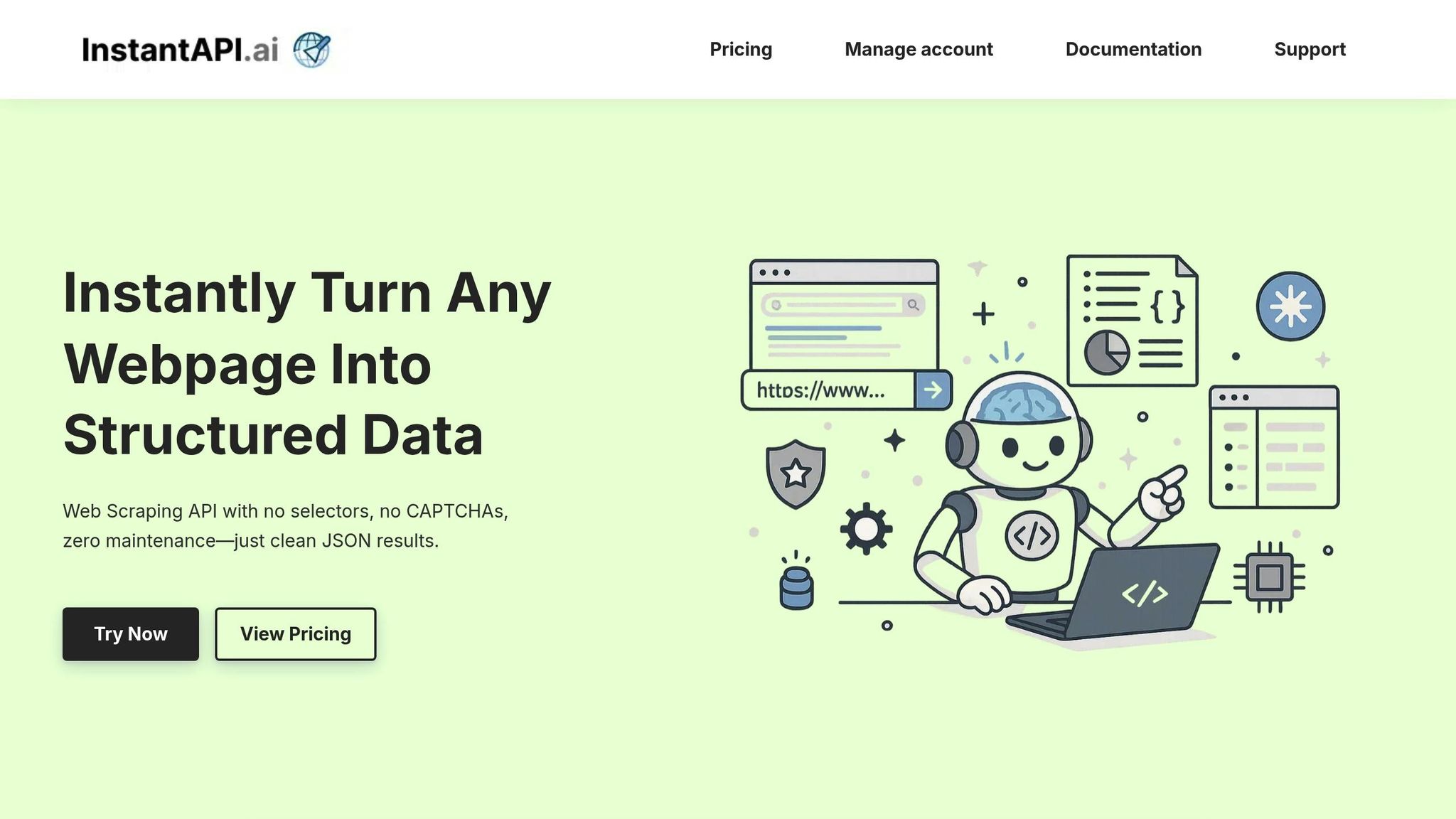
If you’re looking for a simple way to implement the methods we’ve discussed, InstantAPI.ai is a powerful solution. It eliminates common challenges like proxy rotations, JavaScript rendering issues, and CAPTCHA problems. With just one API call, you can retrieve structured JSON data from any webpage.
The platform boasts a 99.99%+ success rate, so you can spend less time troubleshooting and more time analyzing consumer behavior. And at just $2 per 1,000 web pages scraped, with no minimum spend, it’s an affordable option for businesses of any size - whether you’re testing the waters or scaling up.
"After trying other options, we were won over by the simplicity of InstantAPI.ai's Web Scraping API. It's fast, easy, and allows us to focus on what matters most - our core features." - Juan, Scalista GmbH
One standout feature is its global geotargeting capability, which is invaluable for analyzing location-specific trends. Whether you’re tracking regional pricing or local sentiment, this tool helps you uncover how preferences differ across markets and demographics.
Next Steps for Businesses
Start by defining your objectives. Are you analyzing competitor pricing, tracking customer sentiment, or spotting new product trends? Your goals will guide you in selecting the right websites and data points to target.
Begin small - test your process on 2-3 competitor sites or a single social media platform. Focus on specific data elements like product descriptions, customer reviews, pricing details, or engagement stats. This approach helps you fine-tune your methods without being overwhelmed.
Consistency is key. Set up regular data collection schedules instead of relying on one-off extractions. Consumer behavior shifts quickly in digital spaces, so frequent updates - whether weekly pricing checks, daily sentiment tracking, or monthly review analysis - are essential for spotting trends.
Finally, establish clear KPIs to measure the impact of your scraping efforts. Track metrics like data accuracy, collection frequency, and - most importantly - how these insights influence your decisions. Use tools like Google Analytics to evaluate performance changes after integrating web scraping into your strategy.
FAQs
How can businesses stay compliant with legal regulations when using web scraping to analyze consumer behavior?
To use web scraping for consumer behavior analysis without running into legal trouble, businesses need to stick to some important guidelines.
First, always respect copyright laws. Avoid scraping copyrighted material unless you have explicit permission to do so. Second, make sure you're not violating the Computer Fraud and Abuse Act (CFAA). This means you shouldn't access websites without proper authorization or ignore their terms of service - many sites specifically forbid scraping. Lastly, be cautious with personal data. Follow privacy regulations like the California Consumer Privacy Act (CCPA) and the General Data Protection Regulation (GDPR) to ensure you're handling sensitive information responsibly and legally.
By following these steps, businesses can gather consumer insights in a way that's both ethical and compliant with the law.
What sets AI-powered web scraping apart from traditional web scraping tools?
The Key Difference Between AI-Powered and Traditional Web Scraping
The main distinction between AI-powered web scraping and traditional methods comes down to how they handle changes and complexity. Traditional tools rely on predefined rules, such as CSS or XPath selectors, to pull data from static web pages. These methods work well for straightforward, predictable websites. However, when site layouts change or dynamic content is involved, these tools often require manual adjustments, which can be time-consuming.
On the other hand, AI-powered web scraping takes a smarter approach by using machine learning and natural language processing. These technologies allow the tools to automatically adapt to changes in website structures, making them ideal for navigating complex, dynamic sites. They can replicate human browsing behavior, which enhances data accuracy. Additionally, many of these tools come with built-in features like automatic error handling and smart proxy management, which help simplify workflows and save time during data collection.
How can web scraping help businesses optimize their pricing strategy and stay competitive?
Web scraping gives businesses a powerful way to fine-tune their pricing strategies by delivering real-time insights into competitor pricing, market trends, and customer preferences. With this information in hand, companies can adjust their prices dynamically, ensuring they remain competitive while identifying the sweet spot for pricing their products or services.
It also helps businesses keep an eye on pricing strategies across various market segments. This allows them to refine their offerings and better meet customer expectations. By relying on data to guide decisions, companies can strengthen their market position and stay adaptable in today’s ever-changing landscape.
